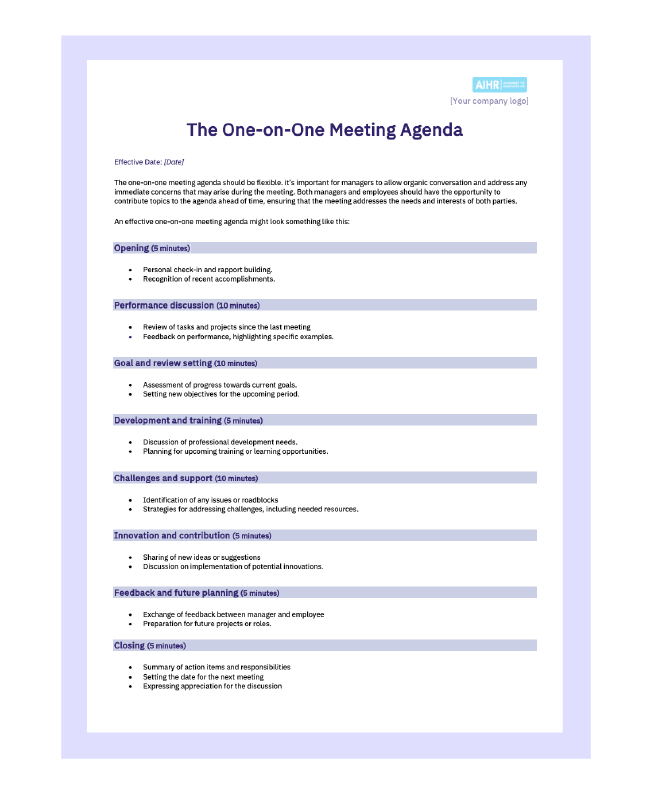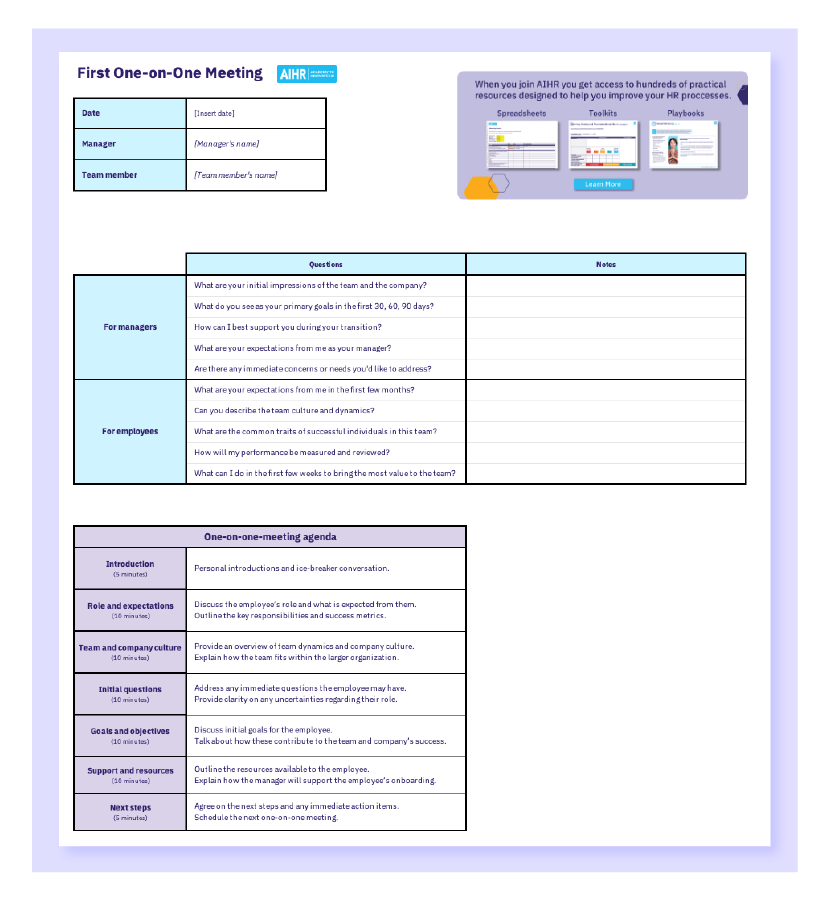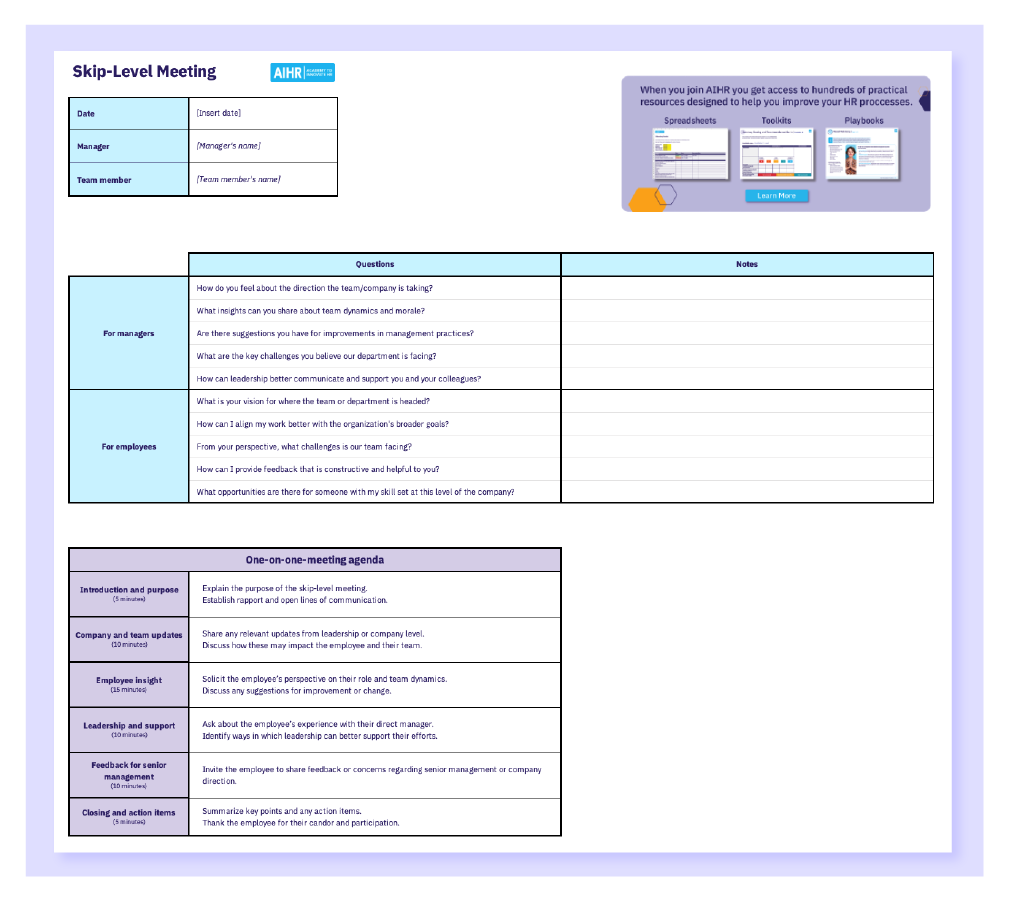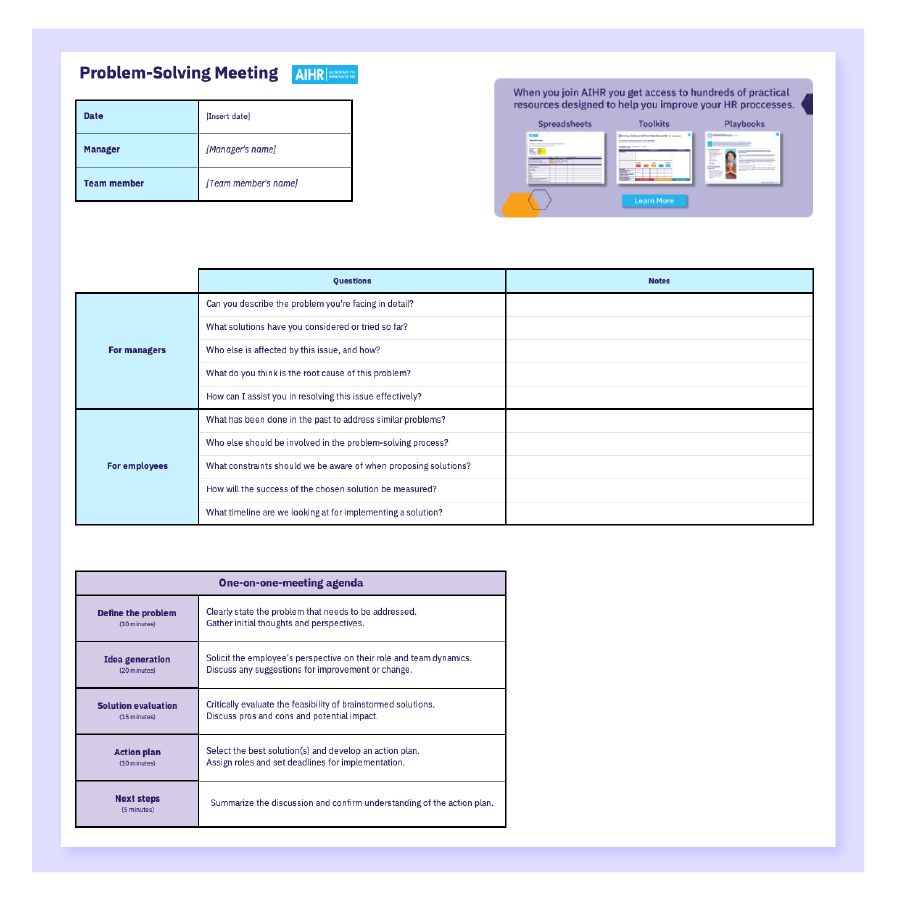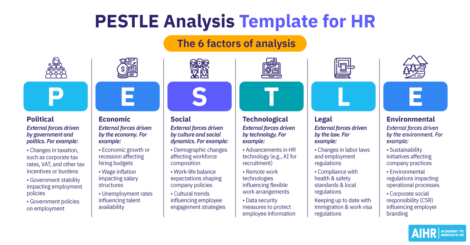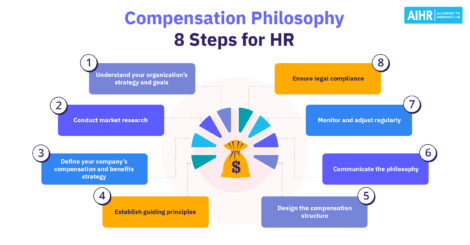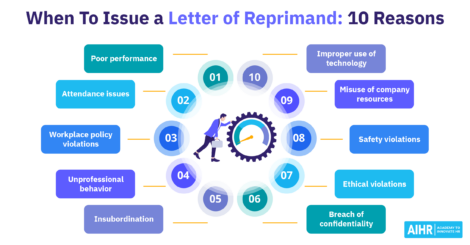The Best [Free] One-on-One Meeting Template and Guide

A one-on-one meeting is an opportunity for managers to check in with their direct reports and for employees to have dedicated time with their managers to discuss any opportunities, challenges, or daily issues they are having in the workplace.
It’s often considered the most important meeting a manager can have because it lays the foundation for a trusting and productive work relationship. However, many managers are unsure how to run them or what should be covered for the greatest impact.
That’s where you, as an HR professional, can add value to the entire process.
Contents
What is a one-on-one meeting?
How to prepare for a one-on-one meeting
How to run a one-on-one meeting
Top tips from HR for managers and employees
Free one-on-one meeting templates
What is a one-on-one meeting?
A one-on-one meeting, also referred to as a 1-on-1 meeting, is a dedicated interaction between two individuals within the same organization, typically between a manager and their direct report. This meeting is a cornerstone of effective management and a critical component of ongoing performance management. As an HR professional, you can help managers and employees understand the importance and benefits of regular one-on-one meetings and provide a proven template and questions that managers can follow.
The main purpose of a one-on-one meeting is to give a private space for both parties can engage in open dialogue, away from the distractions of group settings or the pressures of formal performance reviews. During these sessions, the agenda can cover a range of topics including, but not limited to, status updates on projects, discussion of any challenges or obstacles, career development opportunities, and the reinforcement of organizational goals and objectives.
The benefits of one-on-one meetings for employees
One-on-one meetings enable employees to discuss their concerns and growth goals in a space where they can speak individually with their manager. These meetings are an ideal platform for constructive feedback, allowing employees to understand their performance and areas of improvement in real time.
This, in turn, can help employees use these meetings to express their career goals, seek advice, and align their objectives with organizational needs and current performance, fostering professional growth.
Gallup’s latest report, How Millennials Want to Work and Live, indicates that learning and growth opportunities are extremely important for 59% of millennials when applying for a job. An impressive 87% of millennials consider ‘opportunities for professional or career growth and development’ as a significant factor to them in a job.
Discussing and mapping career opportunities one-on-one with managers is critical for employee performance and longevity. It can significantly boost employee engagement by making them feel valued and heard within the organization.
The benefits of one-on-one meetings for managers
Managers can use regular one-on-one meetings to gain deeper insights into their team’s strengths, weaknesses, and morale, enabling them to manage more effectively. They can address performance issues early on and provide the necessary support or resources to their reports.
These meetings give employees an opportunity to discuss and address challenges with their managers as they arise. They also give teams an opportunity to reasses and adjust if goals or objectives become irrelevant, so teams can remain agile and adapt as business needs change. By regularly conducting these meetings and following a proven one-on-one meeting template, managers can also develop their leadership skills, particularly in communication, empathy, and problem-solving.
However, the challenge is often time. According to Reclaim’s State of Productivity Report, more than 40% of weekly one-on-one meetings are rescheduled, indicating that these meetings often take a back seat to more ‘urgent’ work. As an HR professional, and within the context of the evident benefits that one-on-one meetings offer both employees and managers, you are ideally positioned to encourage these regular meetings to take place and even capture their frequency rates as a key performance indicator (KPI) for managers.
HR tip
Millennials want feedback about their role, but they almost never ask for it. Instead, they want their managers to care about them as people and for their managers to proactively review their performance and ask about their development goals. However, only 29% of millennials strongly agree that they feel comfortable discussing their life outside of work with their manager. Regular one-on-one meetings can foster mutual respect, trust, and understanding, particularly if managers listen well.
How to prepare for a one-on-one meeting
According to Elizabeth Grace Saunders, author of How to Invest Your Time Like Money, employee one-on-ones are some of the most important productivity tools that managers have.
Unfortunately, employees do not have the same positive reaction to meetings, as these meeting statistics from Zippia reveal:
- 65% of employees agree frequent meetings stop them from focusing on and completing their tasks
- 34% of workers believe that unproductive meetings are the leading cause of revenue loss
- 15% of all work hours devoted to meetings
- 71% of all meetings are unproductive.
One-on-one employee meetings are only a benefit for managers and employees if they are valuable – and that takes preparation. Managers should know what they are doing, why they are doing it, and be prepared for each meeting. Employees should also know exactly what to expect and what is expected of them. Both managers and employees must approach these meetings with a sense of purpose and preparation to ensure they are productive and meaningful.
Here is some straightforward advice you can offer managers and employees.
As the manager, do this:
- Examine the employee’s recent work, noting achievements and areas for improvement. Familiarize yourself with their projects and any challenges they’ve encountered since your last meeting.
- Draft a clear agenda that includes discussion points, goals, and any specific feedback you wish to provide. Ensure there is flexibility to include topics the employee may want to discuss.
- Be ready to deliver constructive feedback. This should be balanced; acknowledge what’s working well in addition to what can be improved.
- Think about the employee’s professional development. Identify potential opportunities for growth and be prepared to discuss them.
- Reflect on the interpersonal dynamics and the overall morale of your team. Be prepared to discuss any relevant issues that may affect the employee.
- Come to the meeting ready to listen actively. This means being fully present, not just to respond, but to understand.
HR tip
Establish separate meetings for performance evaluations and use the one-on-ones to focus on development.
As the employee, do this:
- Conduct a self-evaluation of your recent performance. Identify your successes, areas for improvement, and any help you might need from your manager.
- Prepare a summary of your work since the last meeting. Highlight completed tasks, ongoing projects, and any obstacles you’ve faced.
- Create a list of topics you wish to discuss, including any specific feedback you desire, questions about career development, or areas where you seek guidance.
- Have a set of questions or concerns ready that you want to address. This demonstrates engagement and a proactive attitude towards your professional growth.
- Be prepared to provide feedback to your manager if appropriate. One-on-one meetings are a two-way street, and constructive feedback can help improve team dynamics and management strategies.
- Review your personal and professional goals, ensuring they align with team and organizational objectives. Be prepared to discuss progress and set new objectives as needed.
HR tip
Both managers and employees should approach these meetings with a collaborative mindset. Preparation is more than just having a list of talking points; it’s about being ready to engage in a dialogue promoting development, problem-solving, and mutual respect. By thoroughly preparing for one-on-one meetings, both parties can maximize the value of their time together, leading to enhanced performance and job satisfaction.
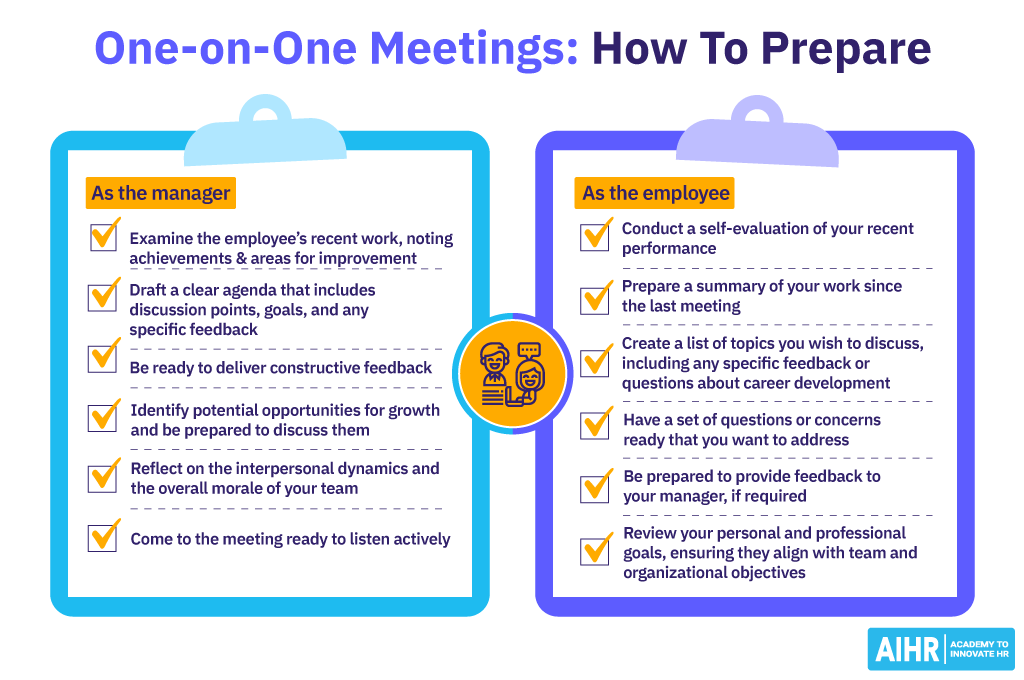
How to run a one-on-one meeting
According to The State of One-on-ones Report, 94% of managers surveyed are having one-on-ones. However, a Harvard Business Review article revealed that nearly half of 250 direct reports surveyed rated their 1:1 experiences as suboptimal. This means that despite the critical nature of one-on-one meetings, they aren’t necessarily having the desired effect. They could even be having the opposite effect.
The Harvard Business Review article also reveals that managers who view one-on-one meetings as a burden and therefore do not invest time or attention into them, or manage them poorly, risk leaving their team members feeling functionally and emotionally disconnected. In these cases, all of the benefits of one-on-one meetings for managers and employees become null and void.
Knowing the benefits of one-on-one meetings, why would managers not invest the necessary time and effort into them? Could it be that they do not know what they are doing?If an organization does not provide clear instructions or training for managers regarding when and how to meet individually with their employees, how do they know how to get the most from them?
The best managers recognize that one-on-one meetings are foundational to their roles, not an add-on, and yet according to research, 68.3% of those same managers who recognize the benefits still struggle to manage their teams along with their other responsibilities.
As an HR professional, this is where you can add guidance and structure to one-on-one meetings.
The one-on-one meeting format
- Preparation: Both manager and employee should prepare for the meeting in advance. This includes setting an agenda, reviewing previous discussions, and identifying key points to cover.
- Agenda setting: While the manager may initially set the agenda, it should be flexible enough to incorporate the employee’s topics of interest or concern.
- Location and atmosphere: The setting should be private and comfortable, ensuring confidentiality and minimizing interruptions.
- Starting the meeting: Begin with a personal check-in to establish rapport. It’s important to start on a positive note, perhaps by recognizing recent achievements.
- Discussion flow: The conversation should flow naturally, but it must cover all agenda items. Both parties should discuss progress, challenges, feedback, and development opportunities.
- Action items: Conclude each topic with clear action items, responsibilities, and deadlines.
- Closing: End the meeting with a summary of action points and a quick preview of the next meeting’s potential agenda. Express gratitude for the time and discussion.
One-on-one meeting frequency
The frequency of one-on-one meetings can vary depending on the organization, the specific roles, and the nature of the work, but there are some key guidelines managers should follow.
First, meetings should be held regularly, often weekly or bi-weekly, to ensure consistency and follow-up on action items. This frequency can be adjusted based on the level of support the employee needs, the pace of work, or during periods of rapid change or high stress. Regardless of the frequency, however, the meetings should be consistently scheduled to demonstrate their importance and to establish a routine.
The purpose of one-on-one meetings
There is more than one purpose behind one-on-one meetings, and your organization might add to this list, but on the whole, these employee meetings are an excellent way to review the progress of the employee’s tasks and responsibilities, providing a platform for immediate feedback.
They are also an ideal opportunity for managers to offer guidance, support, and mentorship, enhancing the employee’s professional development and growth. Once trust is established through regular meetings, any issues or challenges the employee may be facing can be addressed, with the manager and the employee collaboratively finding solutions.
Ultimately, however, the main purpose behind one-on-one meetings is to discuss the employee’s career aspirations and align them with opportunities within the organization, to strengthen the relationship between the employee and the manager, and to ensure that the employee’s efforts are aligned with the organization’s strategic goals.
Before managers embark on their first one-on-one employee meetings, offer them this advice:
Although there is no one-size-fits-all approach to employee meetings, there are some cardinal rules:
- The manager should view this meeting as a dedicated space for the direct report
- The meeting should be dominated by topics relating to the needs, concerns, and hopes of the employee
- The employee should be prepared to take an active role in presenting them.
The manager’s responsibilities are to ensure frequent meetings occur, actively run them, encourage genuine dialogue, ask good questions, offer support, and help each team member get what’s needed for optimal short-term performance and long-term growth.
One-on-one meeting topics
One-on-one meetings are tailored to address the specific needs and circumstances of the employee and manager relationship. However, there are common topics and a general structure that can serve as a template for these meetings.
- Performance review: Discuss the employee’s recent performance, including achievements, work quality, productivity, and areas where improvements can be made.
- Goal setting: Set and review short-term and long-term goals. Ensure these goals are SMART (Specific, Measurable, Achievable, Relevant, and Time-bound).
- Feedback exchange: Provide and solicit feedback on various aspects of work, including project execution, collaboration with the team, and adherence to company values.
- Professional development: Explore opportunities for the employee’s skills enhancement and career advancement within the company.
- Resource needs: Identify any tools, resources, or support the employee may need to perform their job more effectively.
- Workload management: Discuss current workload, potential delegation, and prioritization of tasks to ensure a balanced distribution of responsibilities.
- Challenges and solutions: Address specific challenges the employee is facing and brainstorm potential solutions or strategies for overcoming them.
- Innovation and ideas: Encourage employees to share innovative ideas or suggestions that could benefit the team or the company.
- Personal wellbeing: Check in on the employee’s job satisfaction and wellbeing, recognizing the impact of work-life balance on performance.
- Company vision and alignment: Reiterate the company’s vision and discuss how the employee’s role aligns with and contributes to the company’s strategic goals.
The one-on-one meeting agenda (and free Word template)
Top tips from HR for managers and employees
HR professionals play a pivotal role in guiding managers and employees to maximize the effectiveness of one-on-one meetings. Here are structured tips and advice HR professionals can offer:
For managers
| Do | Don’t |
|---|---|
| Be prepared: Enter each meeting with a clear understanding of the employee’s recent performance, their role within the team, and their current projects. Preparation underscores the value you place on the meeting and the employee’s contributions. | Dominate: Encourage employees to speak openly while guiding the conversation. This balance ensures that the meeting is a dialogue, not a monologue. |
| Establish clear objectives: Define what you aim to achieve with each session, whether it’s tracking progress, providing feedback, or discussing development opportunities. Clear objectives keep the conversation focused and productive. | Forget to follow up: Ensure that any action items or commitments made during the meeting are followed up on. Accountability shows that these meetings have tangible outcomes. |
| Practice active listening: Give your undivided attention to the employee, demonstrating that their insights and concerns are valued. Active listening can often uncover underlying issues and foster a culture of open communication. | Use a one-size-fits-all approach: Recognize that each employee is unique. Customize your approach to suit their individual communication style, preferences, and career aspirations. |
| Cultivate a trusting environment: Create a safe space where employees feel comfortable sharing their thoughts. Trust is fundamental for honest dialogue and for employees to feel genuinely supported. |
For employees
| Do | Don’t |
|---|---|
| Come prepared: Approach the meeting with a clear idea of what you want to discuss. Bring updates on your work, questions, and any issues you’re facing. | Reject feedback: View feedback as a valuable tool for your development. Be receptive and consider how you can use it to improve your performance. |
| Own your development: Take an active role in your professional growth. Discuss your career path, and seek advice and resources that can help you progress. | Set goals and forget them: Work with your manager to set achievable goals. Having clear goals will give you a sense of direction and a benchmark for measuring progress. |
| Communicate clearly: Articulate your thoughts and concerns clearly. If there are specific areas where you need support, be direct about them. | Leave the meeting behind as soon as you walk out the door: After the meeting, take time to reflect on the discussion and plan how you will address any action items. |
| Share your successes: Don’t hesitate to share your achievements. This highlights your contributions and helps your manager understand what works well. |
One-on-one meeting templates
In one-on-one meetings, the questions asked can significantly influence the effectiveness of the conversation. Tailoring questions to the meeting type ensures relevance and productivity.
The templates below provide a categorized list of questions that can be used in various one-on-one meeting scenarios for managers and employees and sample agendas for each. Click on the button to download your free one-on-one meeting template that includes the various types of meetings, with agendas and questions to ask in each.
1. First one-on-one meeting agenda
The first one-on-one meeting between a manager and an employee is a crucial interaction that sets the tone for their working relationship. This meeting is an opportunity for both the employee and the manager to establish a connection, discuss expectations, and align on goals.
2. Onboarding and training meeting
An onboarding and training one-on-one meeting is a launchpad to welcome and integrate new employees into the organization. This meeting is typically conducted between a new employee and a designated mentor, supervisor, or HR representative.
3. Regular check-in meetings
A regular check-in one-on-one meeting is a recurring and scheduled meeting between a manager and an employee. The primary aim of these meetings is to facilitate communication, provide feedback, and address any concerns or questions that the employee may have.
4. Skip-level meetings
A skip-level one-on-one meeting is a type of meeting where a manager meets with an employee who is not directly reporting to them but is part of their team or department. In a traditional organizational hierarchy, a skip-level meeting involves a manager interacting with a subordinate’s direct reports.
5. OKR goal setting and planning
An OKR (Objectives and Key Results) goal-setting one-on-one meeting is a strategic session between a manager and an employee aimed at aligning individual goals with broader organizational objectives using the OKR framework. OKRs are a goal-setting methodology that helps organizations define and track objectives and their corresponding key results.
6. Problem-solving meetings
A problem-solving one-on-one meeting is a focused interaction between a manager and an employee with the primary goal of addressing and resolving specific challenges or issues. These meetings are designed to collaboratively identify problems, discuss potential solutions, and implement strategies to overcome obstacles.
7. Career development meetings
A career development one-on-one meeting is a dedicated session between an employee and their manager or a mentor to discuss the individual’s professional growth, aspirations, and career goals. The primary focus is on mapping out a plan to help the employee progress in their career within the organization.
8. Brainstorming meetings
A brainstorming one-on-one meeting is a collaborative and creative session between two individuals, typically a manager and an employee, where they generate ideas, solve problems, or explore new possibilities. Unlike traditional one-way communication, the goal is to foster open dialogue and innovative thinking.
9. Employee wellbeing meeting
An employee wellbeing one-on-one meeting is a session between a manager and an employee with the primary focus on the employee’s overall wellbeing and satisfaction in the workplace. The purpose of these meetings is to assess and support the employee’s mental, emotional, and physical health, as well as to discuss work-life balance and job satisfaction.
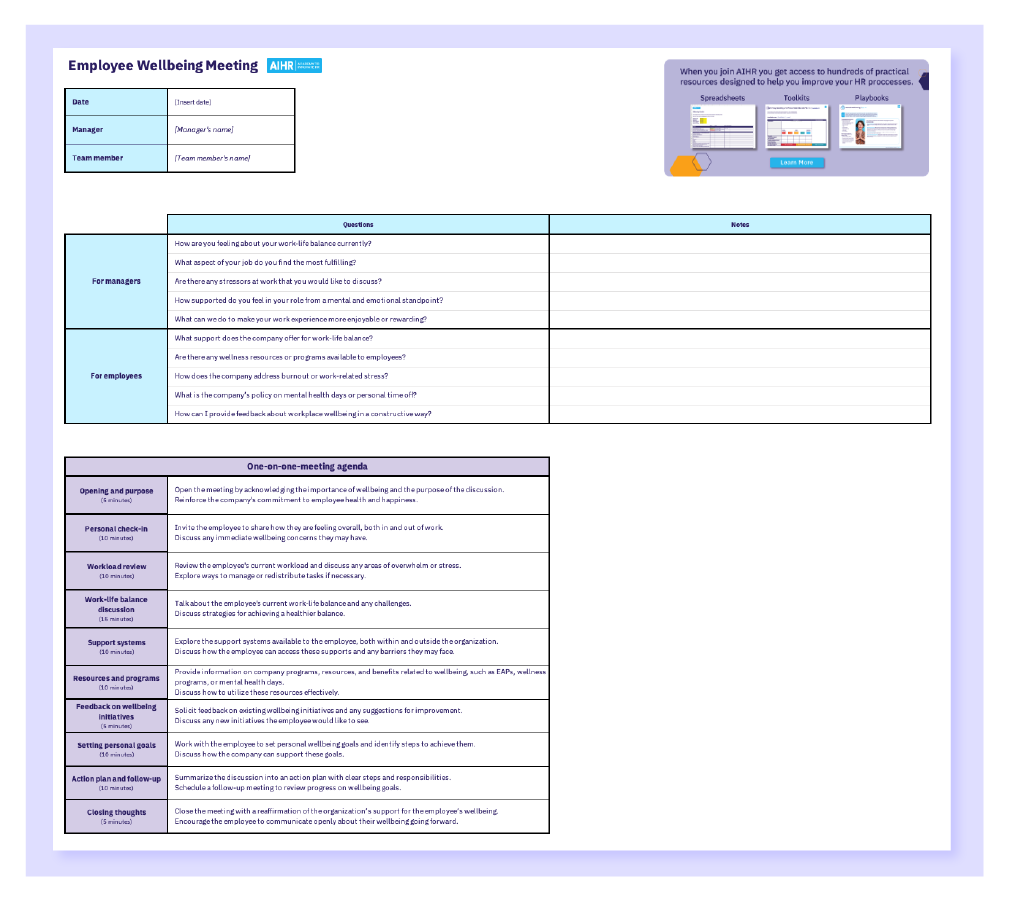
Getting started
If they are run correctly and have the buy-in of managers and employees, one-on-one meetings can add value to individuals, teams and the organization as a whole. Although these meetings are designed to give employees an opportunity to share their feelings and experiences and are therefore not too prescriptive, there are a few key touchpoints that should be addressed.
One-on-one meetings should be regular; if possible, they should not be postponed for more ‘important’ or urgent work; they should be collaborative and a place of trust; and most of all they should not be performance reviews. As an HR professional, you can help managers and employees to make the most of these valuable meetings.
Weekly update
Stay up-to-date with the latest news, trends, and resources in HR
Learn more
Related articles
Are you ready for the future of HR?
Learn modern and relevant HR skills, online





